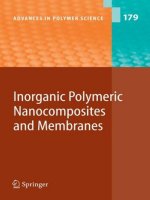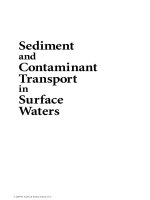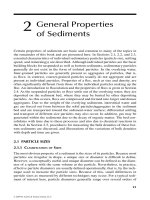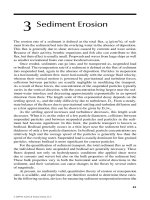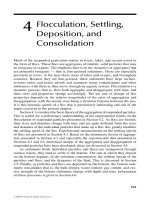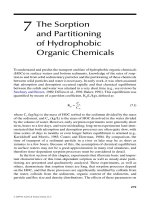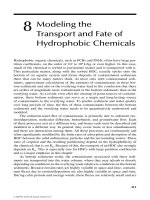Morphology and charge transport in polymer organic semiconductor field effect transistors
Bạn đang xem bản rút gọn của tài liệu. Xem và tải ngay bản đầy đủ của tài liệu tại đây (4.71 MB, 137 trang )
MORPHOLOGY AND CHARGE TRANSPORT
IN POLYMER ORGANIC SEMICONDUCTOR
FIELD-EFFECT TRANSISTORS
ZHUO JINGMEI
(B.Sc. (Hons.), NUS)
A THESIS SUBMITTED
FOR THE DEGREE OF DOCTOR OF PHILOSOPHY
DEPARTMENT OF CHEMISTRY
NATIONAL UNIVERSITY OF SINGAPORE
2011
ii
For my parents
For Jianxiang
iii
iv
Acknowledgements
The work described in this thesis was carried out in the Organic Nano Device Laboratory (ONDL),
National University of Singapore, supported by a research scholarship from the Department of
Chemistry.
This thesis would not have been possible without the support and assistance from many people
whom I would like to thank. I would first like to express my utmost sincere gratitude to my
supervisors, Dr Peter Ho and Dr Chua Lay-Lay for giving me the privilege to work in the group. I
thank them for their guidance, patience and inspiring words. I am also grateful to Dr Sim Wee Sun
for giving me the opportunity to work with him and guiding me in the early years of this research
journey.
Thanks to current and former colleagues, Loke Yuen, Zhi Kuang, Li Hong, Rui Qi, Liu Bo, Siva,
Zhou Mi, Jon, Roland and Bibin for their wonderful company, encouragement and discussions.
Thanks to all junior members in the group for the friendship and adding colors to my PhD journey.
Special thanks to my father for his unconditional support and constant encouragement throughout
my University days. Last but not least, a big thanks to Jianxiang for standing by me and being my
pillar of strength.
v
vi
Declaration
The work in this thesis is the original work of ZHUO Jingmei, performed independently under the
supervision of Dr Peter Ho and Dr Chua Lay-Lay, (in ONDL), Chemistry/Physics Department,
National University of Singapore, between 4 Aug 2007 and 5 Aug 2011.
The content of the thesis has been partly published in:
1. J M. Zhuo, L H. Zhao, R Q. Png, L Y. Wong, P J. Chia, J C. Tang, S.
Sivaramakrishnan, M. Zhou, E. C W. Ou, S J. Chua, W S. Sim, L L. Chua, P. K H. Ho,
“Direct spectroscopic evidence for a photodoping mechanism in polythiophene and
poly(bithiophene-alt-thienothiophene) organic semiconductor thin films involving oxygen
and sorbed moisture”, Adv. Mater., 21 (2009) 4747
2. J M. Zhuo, L H. Zhao, P J. Chia, W S. Sim, R. H. Friend, P. K H. Ho, “Direct evidence
for delocalization of charge carriers at the Fermi level in a doped conducting polymer”,
Phys. Rev. Lett., 100 (2008) 186601
________________ ________________ _______________
Name Signature Date
vii
viii
Abstract
-conjugated organic semiconductor (OSC) is a new class of materials that opens up new
applications in a variety of opto(electronic) devices including field-effect transistors, light-emitting
diodes and photovoltaics. The unique tailorability and solution processability of these materials
lead to a paradigm shift in the design, processing and manufacturing of semiconductor devices.
Industry sources are optimistic that the manufacturing capabilities for large-area light-weight
organic light-emitting diodes (OLED) for high-efficiency display and lighting applications, solar cells
and printed organic thin-film transistor (OTFT) plastic electronic circuits can be put in place.
Despite significant recent advances in the development of high-performance materials, a number
of fundamental aspects of their semiconductor physics and device chemistry remain to be clarified,
including the nature of the charge carriers and interactions between the semiconductor and the
environment. These issues determine their characteristics, such as their charge-carrier mobility
and stability, which underpin technological applications. Among polymer OSCs, the regioregular
poly(3-hexylthiophene) (rr-P3HT) and poly[2,5-bis(3-tetradecylthiophen-2-yl)thieno(3,2-b)thiophene]
(PBTTT) are the two most important models of a semicrystalline -stacked OSC with reasonably
high field-effect carrier mobility that have been widely studied in both organic field-effect transistor
(OFET) and photovoltaic (PV) device applications. This thesis seeks to understand several factors
that influence nature of the charge carriers and their transport in these thiophene-based OSCs.
In chapter 1, a brief introduction to several fundamental OSC topics relevant to this thesis is given.
This includes a short description of rr-P3HT and PBTTT, and the general mechanism and electrical
characteristics of an organic field-effect transistor (OFET). Then a brief review of the known
ix
ambient stability of these materials, and of the known influence of film morphology and gate
dielectric interface on device characteristics is given. Finally the nature of charge carriers in OSCs
is briefly described followed by a short review on charge modulation spectroscopy (CMS).
In chapter 2, a new reversible photo-induced doping mechanism of thiophene-based OSC involving
sorbed moisture uncovered by sensitive Fourier-transform infrared spectrometry is described. This
mechanism explains the degradation of the on – off ratio when these FETs are exposed to the
ambient. The higher resilience of PBTTT compared to rr-P3HT FETs to this doping mechanism is
shown to be largely kinetic in origin. The electrical characteristics of rr-P3HT and PBTTT FETs
were measured with progressive ambient exposure with and without light. In-situ Fourier-transform
infrared spectroscopy (FTIR) was used to probe the initial stages of the evolution of the films and
correlated to the changes in their electrical characteristics. The photo-doping pathway involving
electron transfer from the OSC to the dissolved H
2
O was identified from the increase in the
intensities of the electronic and vibrational transitions of the polarons, and vibrations related to the
hydroxide counter-ions.
In chapter 3, the development of an efficient interferogram-modulated Fourier-transform charge
modulation spectroscopy (FT-CMS) technique to collect the infrared spectra of charge carriers in
FET devices is described. This technique is an improvement over the conventional on-off method
because it allows both the in-phase and out-of-phase spectra to be efficiently collected away from
zero frequency. As demonstration of a first application, the IR spectrum of the hole carriers in
poly(3,4-ethylenedioxythiophene)–poly(styrenesulfonic acid) (PEDT:PSSH) at its Fermi level (E
f
)
has been collected. The spectrum reveals evidence that these holes at the E
f
are surprisingly more
delocalized than in the bulk of this degenerately p-doped disordered material.
x
In chapter 4, evidence for the formation of a transition layer with an unfavorable lying-down
orientation of the polymer OSC at the dielectric interface and charge-carrier trapping in this layer
depending on molecular interactions with the dielectric surface is described. The significance of
this finding is that the bulk organization of the polymer does not extend to the frontier layer at the
interface where the charge-transport occurs, despite widespread assumptions in the literature. The
self-consistent picture that emerges from ultrathin atomic-force microscopy (AFM), near-edge X-ray
absorption fine structure spectroscopy (NEXFAS), UV-Vis spectroscopy and charge-modulated
spectroscopy in both infrared and optical spectral regions, and detailed variable temperature and
variable carrier-density
FET
, using rr-P3HT as model polymer OSC, and various 200 nm-thick SiO
2
substrates with well-defined 1 – 3 nm-thick monolayers as model dielectric surfaces in bottom-gate
FETs explains how dielectric surfaces can so markedly influence the
FET
of the charge carriers
even amongst films prepared under identical conditions.
xi
xii
Table of Contents
Acknowledgements v
Declaration vii
Abstract ix
Table of Contents xiii
List of Figure xv
Chapter 1. Introduction 1
1.1 Organic semiconductors 1
1.1.1 Poly(3-alkylthiophene) 3
1.1.2 Poly(bithiophene-alt-thienothiophene) 8
1.2 Organic field-effect transistors (OFETs) 9
1.2.1 Importance of film morphology 12
1.2.2 Gate dielectric 13
1.2.3 Ambient stability of OFETs 15
1.3 Nature of charge carriers 16
1.4 Charge carriers characterization: Charge modulation spectroscopy (CMS) 19
1.5 References 21
Chapter 2. Photo-doping mechanism in polythiophene and poly(bithiophene-alt-
thienothiophene) organic semiconductor thin films 27
2.1 Introduction 28
2.2 Experimental methods 30
2.2.1 Fabrication of OFETs 30
2.2.2 Electrical characterization of OFETs 30
2.2.3 In-situ FT-IR measurement of thiophene films 31
2.2.4 X-Ray powder diffraction 31
2.3 Results and discussion 32
2.3.1 The impact of ambient exposure on device characteristics 32
2.3.2 Spectroscopic changes in the semiconductor films 35
2.3.3 Role of oxygen and moisture in the photo-doping pathway 41
2.3.4 On the origin of higher stability 45
xiii
xiv
2.3.5 Improved stability: Device encapsulation 47
2.4 Conclusion 49
2.5 References 50
Chapter 3. Interferogram-modulated Fourier-transform charge modulation spectroscopy55
3.1 Introduction 56
3.2 Experimental 59
3.2.1 Device fabrication 59
3.2.2 Development of an interferogram-modulated FT-CMS method 59
3.2.3 Characterization of the novel experimental method 63
3.3 Direct evidence for delocalization of charge carriers at the Fermi level in a doped
conducting polymer 66
3.4 Conclusion 74
3.5 References 74
Chapter 4. Influence of dielectric surface modification on morphology and charge carrier
properties in rr-P3HT thin films 77
4.1 Introduction 78
4.2 Experimental methods 80
4.2.1 Surface modification 80
4.2.2 Atomic force microscopy 81
4.2.3 Ultraviolet – visible Spectroscopy 81
4.2.4 Near-edge X-ray absorption fine structure spectroscopy 82
4.2.5 Variable temperature field-effect transistors characterization 82
4.2.6 Charge modulation spectroscopy in mid-IR to visible region 83
4.3 Results and discussion 84
4.3.1 Overview of field-induced transport characteristics 84
4.3.2 Structural characterization 88
4.3.3 Character of field-induced polarons 100
4.3.4 Character of field-effect transport on different surfaces 107
4.4 Conclusion 109
4.5 References 110
Chapter 5. Outlook 115
Appendix 117
List of Figure
Figure 1.1 Illustration of -conjugation in 1,3-butadiene. The pure p
z
orbitals of two adjacent carbon atoms
overlap to form orbitals where electrons are delocalized over the entire molecule. 3
Figure 1.2 Chemical structure of regioregular poly(3-hexylthiophene) (rr-P3HT) 4
Figure 1.3 Schematic of the molecular packing of regioregular P3HT. The planar conjugated backbones are
cofacially stacked along the b-axis while the alkyl side chains are separated along the a-axis 5
Figure 1.4 Atomic force microscopy (AFM) image of a 50 nm-thick rr-P3HT film spun from chlorobenzene
on hexamethyldisilazane (HMDS)-treated SiO
2
/Si substrate. 6
Figure 1.5 AFM image of P3HT nanofibers spincoated on SiO
2
/Si substrate using a solvent mixture of
anisole/ chloroform (4:1 vol. %).
10
Scan size is 5 x 5 m 6
Figure 1.6 Chemical structure of poly[2,5-bis(3-tetradecylthiophen-2-yl)thieno(3,2-b)thiophene] (PBTTT). 8
Figure 1.7 AFM image of thin PBTTT film (approximately 20 nm) heated to the liquid-crystal regime.
25
9
Figure 1.8 Schematic of a bottom-gate, bottom-contact FET where S and D are the source and drain
electrode respectively. 10
Figure 1.9 Typical current- voltage characteristics of an rr-P3HT based bottom- gate, bottom- contact FET.
Left and right panel shows the transfer and output characteristics respectively. 11
Figure 1.10 Increase in the spread of DOS in the semiconductor at the interface with the dielectric due to
local polarization.
34
14
Figure 1.11 Formation of a polaron where a transition from a benzenoid-like sequence in the neutral
polythiophene chain to a quinoid-like bond sequence occurs 17
Figure 1.12 Energy level diagram of a neutral polymer and polaronic absorptions in a simple isolated chain
model of radical cations and dications. The C3, C4 and DC2 transitions are usually forbidden due to
symmetry considerations. 18
Figure 2.1 FET transfer characteristics of rr-P3HT sequentially acquired after different exposure conditions.
Left and middle panels give the linear and log plots respectively; right panel lists the exposure conditions.
“Ambient air” is cleanroom air (22ºC, RH 60%); “light” corresponds to an absorbed photon flux intensity of 9
x 10
13
ph s
–1
cm
–2
; h = hour, d = day, wk = week 34
Figure 2.2 FET transfer characteristics of PBTTT sequentially acquired after different exposure conditions.
Left and middle panels give the linear and log plots respectively. The set of exposure conditions for the
device is listed on the right panel. “Ambient air” and “light” are as defined in Figure 2.1 34
xv
Figure 2.3 FTIR spectra of rr-P3HT film acquired sequentially after different in-situ exposure to cleanroom
air. (a) Reference spectrum of film in vacuum. (b) Difference spectra obtained by subtracting the
spectrum of the film in vacuum, offset for clarity. Spectra of gas-phase H
2
O and CO
2
have also been
removed for clarity. “Air” is cleanroom air (22ºC, RH 60%), and “light” corresponds to an absorbed photon
flux intensity of 2.0 x 10
15
ph s
–1
cm
–2
. 37
Figure 2.4 FTIR spectra of PBTTT film acquired sequentially after different in-situ exposure cleanroom air.
(a) Reference spectrum of film in vacuum. (b) Difference spectra obtained by subtracting the spectrum of
the film in vacuum, offset for clarity. Molecular spectra of gas-phase H
2
O and CO
2
have also been removed
for clarity. “Air” and “light” are as defined in caption of Figure 2.3 38
Figure 2.5 Difference spectra by subtracting the spectrum of the rr-P3HT film in air and in the dark. Spectra
labels are the same as in Figure 2.3(b) 40
Figure 2.6 Difference spectra by subtracting the spectrum of the PBTTT film in air and in the dark. Spectra
labels same as in Figure 2.4(b) 40
Figure 2.7 Difference FTIR spectra of rr-P3HT films by subtracting the spectrum of the film equilibrated in
the following atmospheres in the dark from those acquired sequentially after different in-situ light exposure:
(a) in dry synthetic air (pO
2
= 21%; pH
2
O < 5 ppm), and (b) in wet N
2
(RH 66%, pO
2
< 1 ppm). Spectra
labels same as in Fig. 2.3(c). “Ambient air” and “light” are as defined in caption of Fig. 2.3(c) 43
Figure 2.8 Schematic of energetic levels of acceptor species relevant to the photo-hole-doping of the
organic semiconductor. All energies refer to the solid-state, but without Coulomb relaxation. 45
Figure 2.9 –2 XRD diffractograms of 1 mm-thick films of (a) rr-P3HT and (b) PBTTT at room temperature
in vacuum (10
–2
mbar) using Cu K
radiation. Solid line is data, dotted line is fitted amorphous background
using a sum of two Gaussians 47
Figure 2.10 Schematic of the cross- section of an rr-P3HT FET capped with a layer of PDMS film 48
Figure 2.11 FET transfer characteristics of rr-P3HT capped with a layer of 1 mm-thick PDMS film. (i)
Pristine and (ii) After exposure to the ambient for 30 min. “Ambient” corresponds to cleanroom air (22ºC, RH
60%) and an absorbed photon flux intensity of 9 x 10
13
ph s
–1
cm
–2
.
Left and right panels give the linear and
log plots respectively 48
Figure 3.1 The chemical structure of PEDT:PSSH 58
Figure 3.2 Schematic of a classic Michelson interferometer which consist of the three major components: a
fixed mirror, moving mirror and a beam splitter 60
Figure 3.3 Data acquisition scheme for the space-resolved step-scan FT-IR experiment. The interferogram I
() constructed is shown in the left panel 61
Figure 3.4 A schematic of the interferogram-modulated FT-CMS experiment. Top left inset shows the cross-
section of device used in the experiment 63
xvi
Figure 3.5 Tests with chopping of the beam at focus. In-phase and quadrature ac ΔT/T spectra (circles,
20% of data shown); scaled rapid-scan dc spectrum (continuous line); and the ratio spectrum of in-phase ac
to dc (squares). Inset: Relative amplitude and phase response of the MCT detector vs f
mod
(circles) and
theoretical response of a 150 kHz- bandwidth detector (lines). 65
Figure 3.6 Absorption spectrum of a 1:2.5 mol/mol PEDT:PSSH measured in transmission in N
2
.
Resolution= 16 cm
–1
. Inset: IV characteristic of the interdigitated device (length L = 20 m; width w = 22.5
cm; area A ≈ 3 x 3 mm
2
; film thickness t = 50 nm). 67
Figure 3.7 CMS ∆T/T magnitude spectra for excitation conditions (i)–(iv) as shown in the inset. No
irreversible change occurred in the IV characteristics of the device measured again at the end of each
experiment. The phase spectrum is ≈ 0º and spectrally flat. The ∆T/T spectrum thus corresponds to
induced transmission (i.e., bleaching) in phase with the peak in the voltage (and current) excitation cycles.
Resolution, 50 cm
–1
due to mathematical smoothing using a smoothing spline function; expanded spectrum
resolution, data collected at 16 cm
–1
resolution for conditions similar to (v) and unsmoothed 69
Figure 3.8 Experimental spectra (solid line, left axis) and computed spectra (dotted line, right axis) from the
Drude model modified for weak localization 72
Figure 3.9 Schematic of the effects of interchain interaction (top) and random potential (bottom) on the
energy of carriers in doped conducting polymers, both leading to finite D(E
f
), but with different optical gaps.
Effects of random potential are drawn to be less severe for delocalized carriers. These energy levels
correspond to one-electron states, so the classical “half-filled” polaron band is obtained only when the upper
band meets the lower band 73
Figure 4.1 Schematic of the SiO
2
/Si surface after surface treatment with oxygen-plasma,
hexamethyldisilazane (HMDS), octadecyltrichlorosilane (OTS) and 1,1,2,2-4H-
perfluorodecyldimethylchlorosilane (PDS) 80
Figure 4.2 Experimental setup for charge modulation spectroscopy in the visible spectra range 84
Figure 4.3 Left panel: Field-effect hole mobilities of rr-P3HT transistors fabricated on different modified
SiO
2
/Si surfaces. The mobilities were extracted from the linear regime at V
g
= -60V and V
d
= -40V. Right
panel: Arrhenius plot of the four corresponding devices. Symbols are experimental data; lines are best- fit
lines from which the apparent field-effect mobility activation energy is derived. The activation energy
increases in the order of O
2
< OTS < PDS << HMDS. 86
Figure 4.4 Transfer curves of a device fabricated on OP-treated substrate at T = 85K, 150K, 200K and
295K. 87
Figure 4.5 UV-Vis absorption spectra of 20nm-thick rr-P3HT spin-cast from 9 mg mL
-1
solution on OP, OTS,
PDS and HMDS -treated glass substrates 88
Figure 4.6 AFM images of 20 nm-thick rrP3HT films on OP, OTS, PDS and HMDS-treated Si substrates 89
xvii
xviii
Figure 4.7 UV-Vis absorption spectra of ultrathin rr-P3HT spin-cast from 0.36 mg mL
-1
solution on OP, PDS
and HMDS-treated substrates. 90
Figure 4.8 AFM images of ultrathin rrP3HT films on OP, PDS and HMDS-treated SiO
2
/Si substrates and
their corresponding height-distribution histograms. The height corresponding to the lying-down fraction,
lamellar stack and their multiples are marked on the histograms. 92
Figure 4.9 Diagram illustrating the definition of angles , and 96
Figure 4.10 Total-electron-yield- near-edge X-ray absorption spectroscopy (TEY-NEXAFS) spectra of rr-
P3HT spin-cast from chlorobenzene onto OTS-treated and PDS-treated native silicon substrate. Top panel
shows the spectra of the film at the air interface. Bottom panel shows the spectra of the film at the substrate
interface revealed by gentle delamination. The average angle between the thiophene ring normal and the
film normal is denoted by <> 98
Figure 4.11 Dichroic analysis of the polarization-angle dependence of absorption of the incident X-rays for
the C
1s
→1* transition at 285.0 eV for the film at the substrate interface (squares) and the air interface
(circles). 99
Figure 4.12 Approximate examples of rr-P3HT on SAM-modified surfaces 99
Figure 4.13 Transfer curve of devices fabricated on OP, OTS, PDS, and HMDS-treated substrates,
measured before CMS experiments at 298K 101
Figure 4.14 In-phase CMS optical spectra of the holes accumulated in the channel of rr-P3HT FETs
fabricated on different surface-modified substrates measured at 298K (offset for clarity). Solid lines show
spectra for high
dc
= 6.8 x 10
12
cm
–2
and dotted lines show spectra for moderate
dc
= 3.8 x 10
12
cm
–2
, with
root-mean-square (rms) = 0.2 x 10
12
cm
–2
at 170 Hz. Shaded regions represent spectrum difference
against that of the HMDS device at
dc
= 6.8 x 10
12
cm
–2
. The quadrature spectra show no features and
hence no slow or irreversible processes. Inset shows the ratio of the delocalized polaron intensity at ca. 1.9
eV to the intensity at 1.28 eV 102
Figure 4.15 In-phase FT-IR CMS spectra for rr-P3HT transistors fabricated on SAM-modified surfaces at
298K. The devices were biased in the accumulation regime at
dc
= 3.0x10
12
cm
–2
, with root-mean-square
(rms) = 1.4x10
12
cm
–2
at modulation frequency of 170 Hz. Solid lines represent data and horizontal lines
indicated zero; dotted lines are guide to the eye 106
Figure 4.16 Plots of the field-effect mobility against inverse temperature at different hole densities. Symbols
are data; lines represent predictions using the Coehoorn generalized hopping model. Inner scales on the left
plots indicate
FET
on a log scale 108
Figure 4.17 Plot of the Fermi energy and DOS width against hole densities for devices fabricated on OTS,
OP, PDS and HMDS-treated substrates. Zero corresponds to the center of the Gaussian-like DOS 109
Chapter 1. Introduction
1.1 Organic semiconductors
The first studies of organic semiconductors date back to the early 20
th
century and the
scientific research in organic electronics has since witnessed extraordinary growth and
garnered significant industrial interest for the past few decades. Intensive research in organic
electronics driven by the prospect of low cost fabrication, low temperature processing
techniques and structural flexibility in contrast to conventional inorganic semiconductors-based
technology was spurred on when Alan J. Heeger, Alan G. MacDiarmid and Hideki Sirakawa
were jointly awarded the Nobel Prize in Chemistry in the year 2000 for “the discovery and
development of conductive polymers”.
1
To date, the most advanced organic electronic systems
already available commercially are thin displays based on organic light-emitting devices
(OLEDs)
2
, notably in the displays of mobile electronic appliances. Significant progress is also
made in the realization of thin film transistors in which performance is comparable to that of
vacuum-deposited amorphous silicon (a-Si) where field-effect mobilities is between 0.5 – 1
cm
2
V
-1
s
-1
, and organic photovoltaic (OPV) cells
3
that make low-cost solar energy generation
possible. Other demonstrations as potential candidates of organic-based electronics include
chemical sensors
4
and RFID tags which aim to replace conventional barcodes.
Organic semiconductors are carbon-rich compounds with semiconducting properties. Of the
various types of -electron system, conjugated polymeric semiconductors have been at the
centre-stage of research and development for the last decade. Short chain oligomers or small
1
molecules are usually deposited by vacuum sublimation which is disadvantaged in terms of
cost and large-area fabrication. Polymers on the other hand are solution-processable and thus
can be deposited via a variety of coating methods such as simple spin-coating, drop-casting or
inkjet-printing with which large-area fabrication on flexible plastic sheets is possible. These
polymers are long-chain molecules, typically made up of an indeterminate number of aromatic
monomer repeating units coupled together where the chain consists of alternating single (-
bonds) and double bonds (-bonds), termed conjugation (illustrated in Figure 1.1). The
orbital conjugation is extended along the length of the polymer chain and electrical conduction
in these compounds is made possible with the help of delocalized -electrons. The filled -
orbitals form the valence band while the empty *-orbitals form the conduction band. The
presence of a small but non-zero energy gap between the highest occupied molecular orbital
(HOMO) and the lowest unoccupied molecular orbital (LUMO) results in a semiconducting
nature instead of a metallic conduction. The extent of delocalization of -electrons determines
the size of this energy gap. The structures of the polymers can be tailored to optimize a
desired property such as high charge mobility or luminescent properties via tuning the energy
gap in these materials.
2
Figure 1.1 Illustration of -conjugation in 1,3-butadiene. The pure p
z
orbitals of two adjacent carbon
atoms overlap to form orbitals where electrons are delocalized over the entire molecule.
1.1.1 Poly(3-alkylthiophene)
Of all conjugated polymers, thiophene-based polymers have exhibited one of the highest
charge carrier mobilities from OFETs fabricated by spin-casting. Poly(3-alkythiophenes) were
among the first polymers to exhibit high field-effect mobilities
5
of up to 0.1 cm
2
V
-1
s
-1
,
6
and regio-
regular poly(3-hexylthiophene) (rr-P3HT)
7,8
has emerged as one of the most widely studied
polymer for FETs and PV applications. The observations based on this model system have
provided critical guidance for the chemical design of new high-performance polymers that can
supersede its performance in FETs.
3
S
S
S
S
n
S
S
S
S
n
Figure 1.2 Chemical structure of regioregular poly(3-hexylthiophene) (rr-P3HT).
The thiophene units in P3ATs are coupled together at the second and fifth positions and adopt
a coplanar conformation, providing a template for achieving highly crystalline thin-film
microstructure while the alkyl chains are attached in a head-to-tail arrangement as shown in
Figure 1.2. An extended delocalized electronic orbital system is formed where conjugation
extends through the electron-rich thiophene rings. Regioregular P3HT packs such that the
backbones in the ordered regions are -stacked in lamellar sheets separated by their side
chains
9
as shown in Figure 1.3. The surface morphology of rr-P3HT films is typically nodular
(see Figure 1.4) but it can also exhibit whisker (fibrillar) morphology (as illustrated in Figure 1.5)
with variations in its molecular weight and processing conditions.
4
S
S
S
S
S
S
S
S
S
S
S
S
-stacking
(a-axis)
Lamellar stacking
(b-axis)
S
S
S
S
S
S
S
S
S
S
S
S
-stacking
(a-axis)
Lamellar stacking
(b-axis)
Figure 1.3 Schematic of the molecular packing of regioregular P3HT. The planar conjugated
backbones are cofacially stacked along the b-axis while the alkyl side chains are separated along the a-
axis.
5
200 nm
10 nm
200 nm
10 nm
Figure 1.4 Atomic force microscopy (AFM) image of a 50 nm-thick rr-P3HT film spun from
chlorobenzene on hexamethyldisilazane (HMDS)-treated SiO
2
/Si substrate.
Figure 1.5 AFM image of P3HT nanofibers spincoated on SiO
2
/Si substrate using a solvent mixture of
anisole/ chloroform (4:1 vol. %).
10
Scan size is 5 x 5 m.
6
Various studies using X-ray diffraction and grazing incidence X-ray scattering have shown that
rr-P3HT films are microcrystalline where well-ordered small crystalline domains are embedded
in a largely amorphous disordered matrix.
11,12
The microstructure and hence performance of
P3HT-based OFET depends very sensitively on the degree of head-to-tail regioregularity
5,6
,
molecular weight
13-17
among other processing factors such as boiling point of solvent
5,18
used,
interfacial treatment
19
and deposition method
5,20-22
.
Chang et al.
18
demonstrated an enhancement in the
FET
by spin-coating rr-P3HT of a fixed
molecular weight from high boiling point solvents. It was explained that the high boiling point
solvent allows more time for crystallization to occur during the spin-coating process by
evaporating slowly hence improving the degree of microcrystalline order. This is similar to the
effect of increased drying time in drop-casting method where large morphological difference
and device performance is seen when compared to the spin-coated film. Kline et al.
15
found
that
FET
can vary by as much as four orders of magnitude when the molecular weight is
increased from 3.2 kD to 36.5 kD. The surface morphology in the film changes from whisker-
form to nodular-form in low and high molecular rr-P3HT respectively. They attributed this
observation to the substantial effect of the molecular weight on way rr-P3HT chains pack.
Chang et al.
17
reported similar dependence of
FET
on the molecular weight which was
explained by fewer defects due to folding in the lamellar, leading to a longer conjugation length
and less perturbed interchain packing in longer chains. This reduces the transport dependence
on thermally activated hopping of charges between localized segments of chains hence
increasing the
FET
.
7

